A New Era of Smart Travel: Holiday Inn Express Opens in Midosuji, Osaka
In a significant development for Japan's hospitality sector, IHG has opened its first Holiday Inn Express in the vibrant heart of Midosuji, Osaka. This new property, with its unique blend of functionality and comfort, marks an essential change in the travel landscape. It embodies the brand's philosophy of 'simple, smart travel' and is designed to cater to the needs of today's discerning travellers. With its strategic location, modern amenities, and thoughtful design, the hotel promises a unique and memorable stay experience.
In a significant development for Japan's hospitality sector, IHG has opened its first Holiday Inn Express in the vibrant heart of Midosuji, Osaka. This new property, with its unique blend of functionality and comfort, marks an essential change in the travel landscape. It embodies the brand's philosophy of 'simple, smart travel' and is designed to cater to the needs of today's discerning travellers. With its strategic location, modern amenities, and thoughtful design, the hotel promises a unique and memorable stay experience.
The hotel's design theme, aptly named "Smart & Comfy," is a unique blend of modern travel essence, prioritizing practicality and relaxation. Situated along the prestigious Midosuji Avenue, the hotel's stunning backdrop inspires its interior design, reflecting the grandeur and vibrancy of the area. The careful incorporation of the brand's signature blue colour—symbolizing comfort and trust—adorns the lobby and public spaces, creating an inviting atmosphere that feels familiar and distinctive.
As guests enter the lobby, they are welcomed by a striking reception area filled with deep blue tones, creating a memorable first impression. This bold use of colour highlights the hotel's branding and fosters a sense of warmth and hospitality, encouraging travellers to relax after their journey. At this reception, Osaka's true essence begins to unfold.
The esteemed MITSUI Designtec expertly designed the hotel's interior, combining aesthetic appeal and functionality. A standout feature is the beautifully crafted map installation, which highlights Osaka's most beloved tourist attractions. Positioned for maximum visibility from the reception counter, this interactive art piece serves a dual purpose: a visual delight and a conversation starter. This thoughtful design element fosters interactions between guests and hotel staff, enriching the guest experience by encouraging discussions about the myriad adventures awaiting in the vibrant city of Osaka.


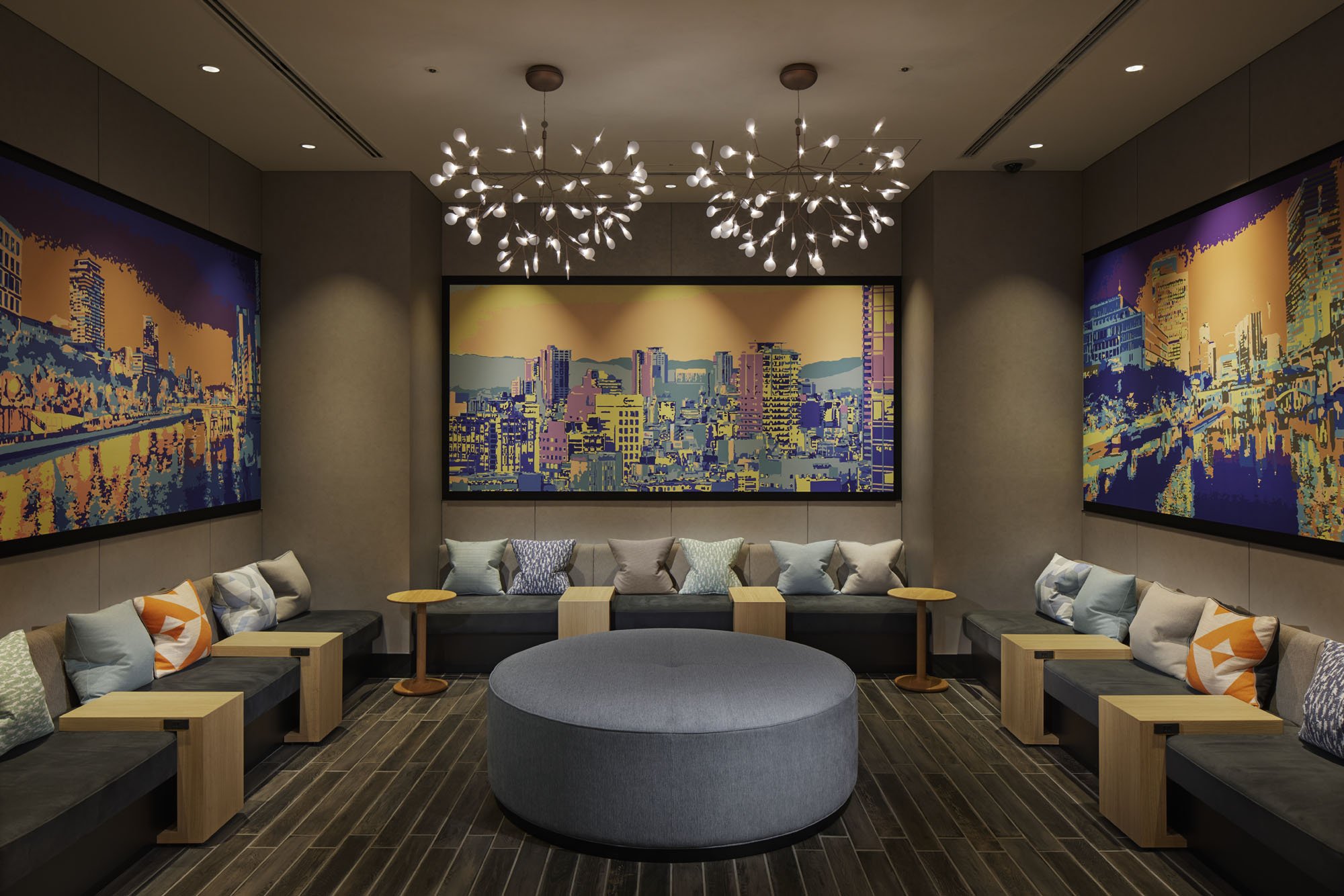
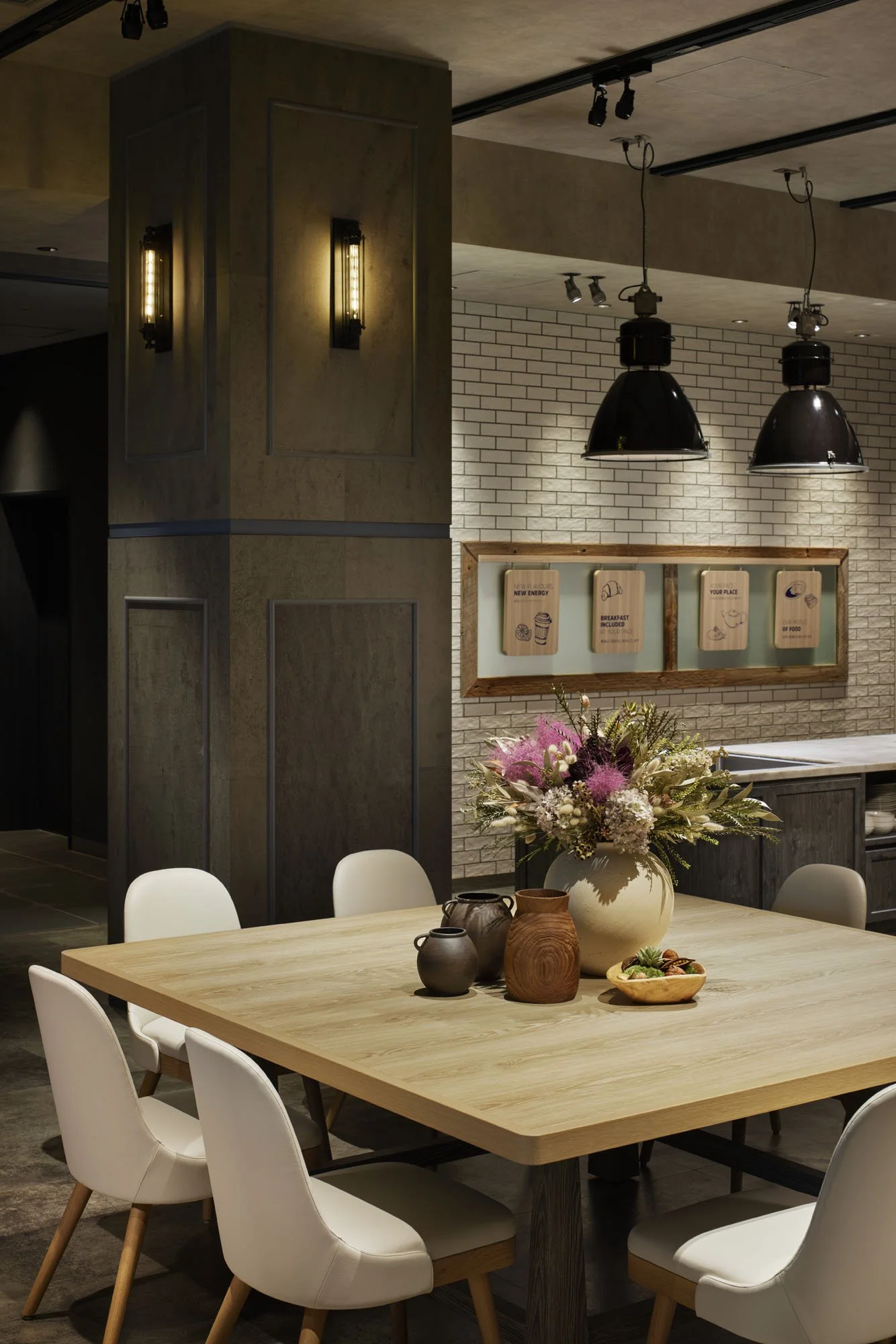
In addition to the map, the hotel features graphic wall art that showcases evocative scenes from the local neighbourhood. This artwork offers guests a visual narrative of their surroundings and a deeper connection to the city's culture. These impressive depictions, including representations of the Osaka dialect, enhance the sense of place, allowing visitors to connect with the city and its culture. Such meticulous attention to the local experience reflects the hotel staff's commitment to ensuring guests leave with cherished memories, creating a bond beyond a typical stay.
The hotel's unwavering commitment to creating a comforting and memorable atmosphere is evident in every aspect of the guest experience. From the well-appointed rooms designed for relaxation to communal spaces that encourage socialization, the Holiday Inn Express in Midosuji is more than just a place to rest; it is a thoughtfully curated environment that celebrates the essence of Osaka while catering to the needs of modern travellers.
As Japan's first Holiday Inn Express, this property sets a new standard for intelligent, comfortable, and culturally attuned hospitality. It reinforces IHG's dedication to blending international standards with local flavours and serves as a testament to Japan's evolving nature of travel. In a city renowned for its rich heritage and vibrant atmosphere, the Holiday Inn Express in Midosuji stands out as a modern hospitality beacon, inviting guests to explore, engage, and create lasting memories in the heart of one of Japan's most dynamic cities.
For more information, please visit: https://www.mitsui-designtec.co.jp/
*This project is one of the shortlisted project in the Sky Design Awards 2024 - Interior Design - Hotel & Resorts Division
Designer Profile
Ultimate Vision: The Shangri-La Eyeglasses Boutique
In a time when luxury retail experiences constantly evolve, Shangri-La Eyeglasses in Sihaicheng is setting a new benchmark. It combines high-end eyewear with a meticulously designed environment, providing an immersive experience. Crafted by Chengyi (Guangzhou) Decoration Engineering Co., Ltd., this boutique design in elevating the retail experience. It invites customers into a realm of sophistication where service and product merge to create something truly unforgettable.
In a time when luxury retail experiences constantly evolve, Shangri-La Eyeglasses in Sihaicheng is setting a new benchmark. It combines high-end eyewear with a meticulously designed environment, providing an immersive experience. Crafted by Chengyi (Guangzhou) Decoration Engineering Co., Ltd., this boutique design in elevating the retail experience. It invites customers into a realm of sophistication where service and product merge to create something truly unforgettable.
Inspired by the concept of Shangri-La—a fabled paradise brought to life in James Hilton's 1933 novel Lost Horizon—the design aims to capture a utopia's ethereal beauty and tranquillity while firmly planting itself in the modern world. The boutique's design concept revolves around escapism and luxury, offering visitors a retreat from the ordinary. It's a place where they can indulge in premium eyewear and an elevated sensory journey. The store is not merely a place to shop but a space where customers can pause and immerse themselves in an atmosphere that mirrors the myth of Shangri-La itself—an oasis of calm, refinement, and exclusivity.
Design Aesthetic: Fusing Tradition and Modernity
The boutique's design philosophy balances traditional opulence and contemporary minimalism. Inspired by the timeless allure of Shangri-La, the design incorporates natural materials like stone, wood, and glass, reflecting the mythical paradise's harmonious relationship with nature. These materials are combined with modern, sleek lines and cutting-edge lighting systems to create an environment that is both inviting and avant-garde.
The store is intentionally spacious, with clear sightlines to guide visitors through a journey of discovery. A central pathway, flanked by custom wooden displays and softly illuminated with ambient lighting, leads customers to the world's most luxurious eyewear brands. Each display is designed with a minimalist approach, allowing the products to be showcased as pieces of art rather than just consumer goods. Reflective surfaces, like polished stone and glass, enhance the feeling of space and light, creating a serene and almost otherworldly atmosphere.
Atmosphere: A Multi-Sensory Experience
The atmosphere of Shangri-La Eyeglasses is carefully designed to create a sense of serenity, luxury, and exclusivity. When customers step inside, they are greeted with a calm environment, ambient music, and a subtle scent of sandalwood, all chosen to evoke warmth and tranquillity. Every element enhances the customer's emotional and psychological experience, making it more than just a place to buy eyewear.
Lighting is crucial in shaping the atmosphere. The boutique uses natural light during the day and a well-programmed lighting system that adjusts based on the time of day and customer flow. Warm, golden hues encourage a relaxed shopping experience during peak hours, while cooler, sharper tones in the evening create a sophisticated ambiance. The lighting is also strategically placed to highlight the craftsmanship of the products on display, enhancing the luxurious feel of the materials and finishes.
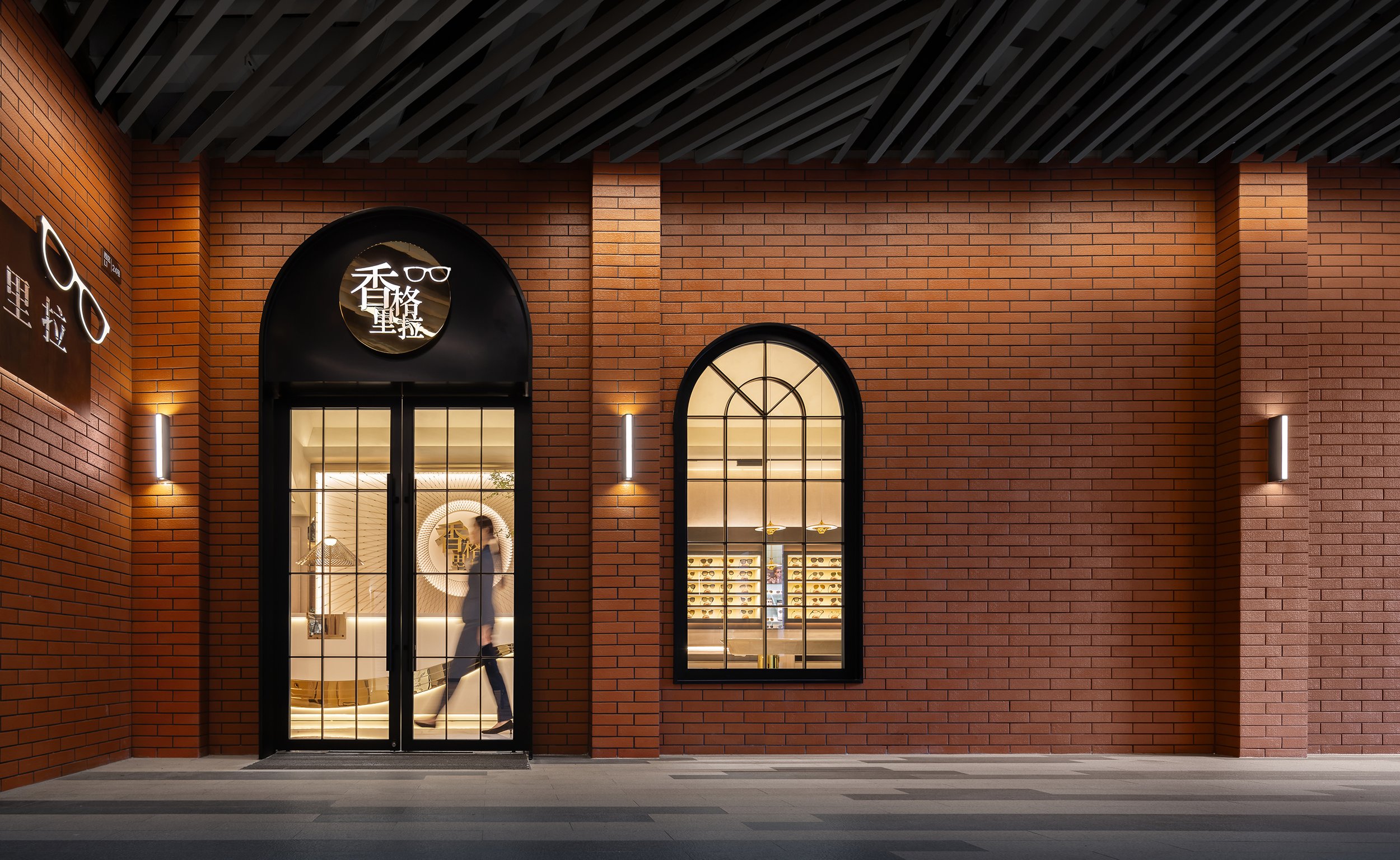

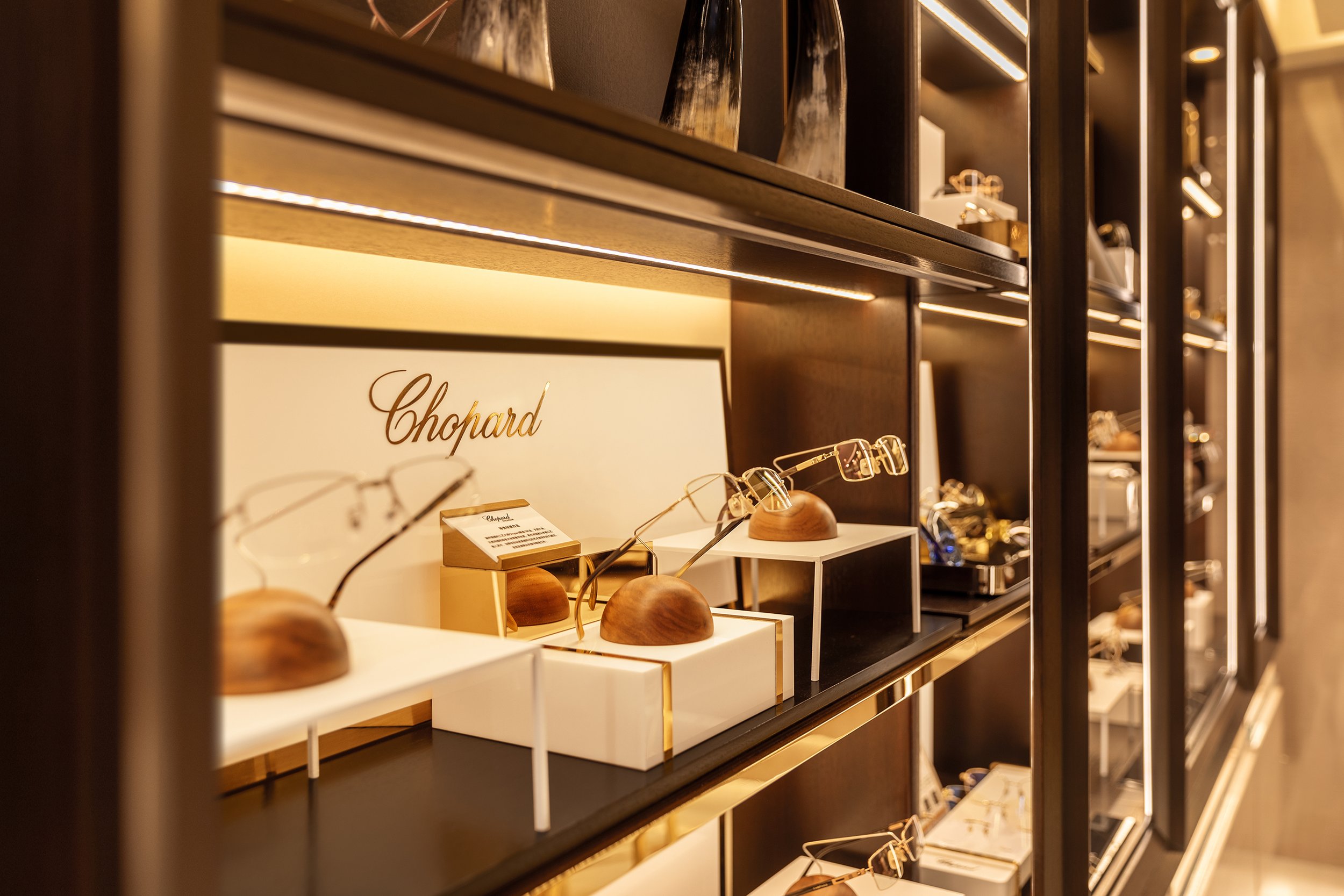

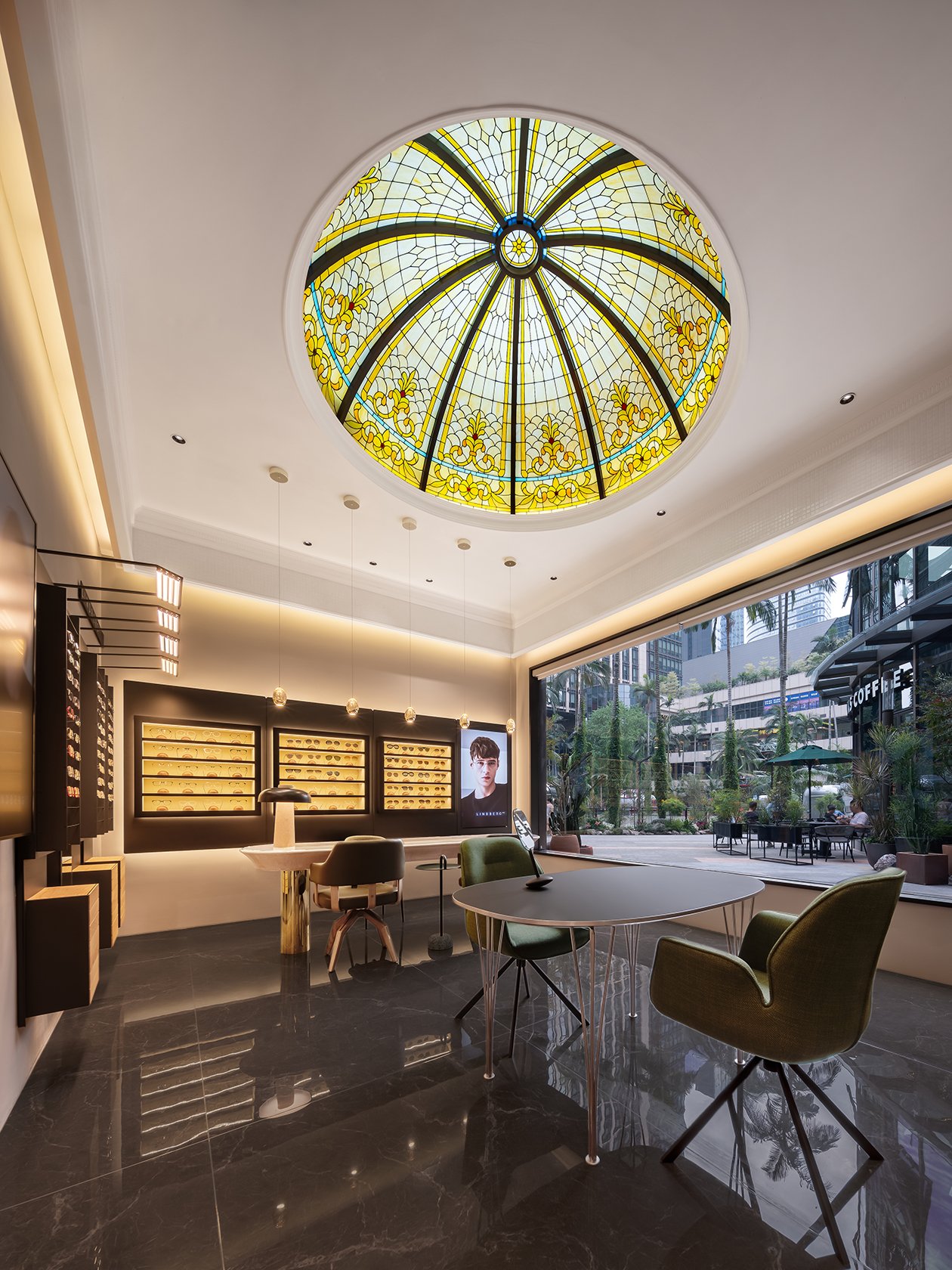
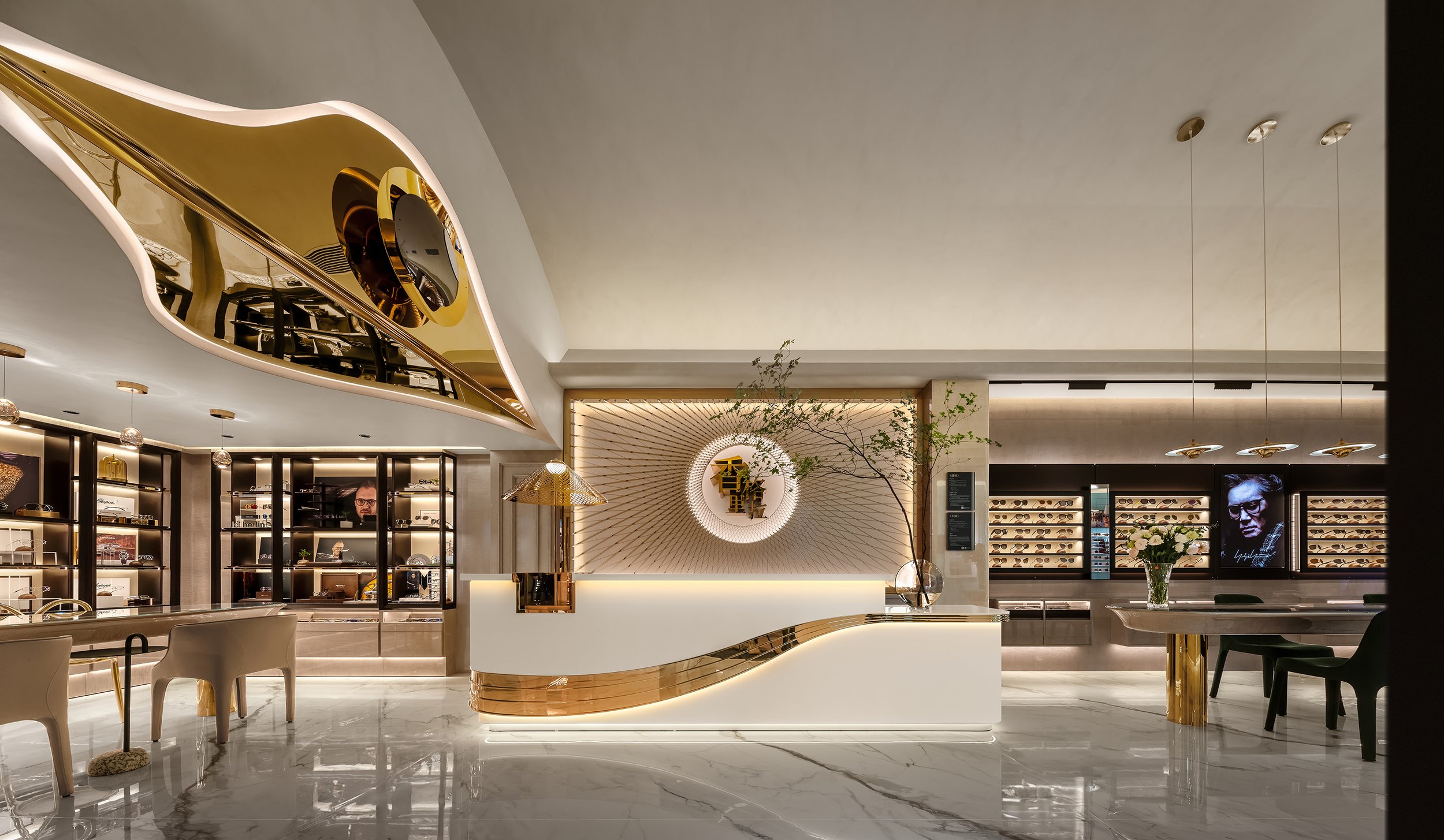
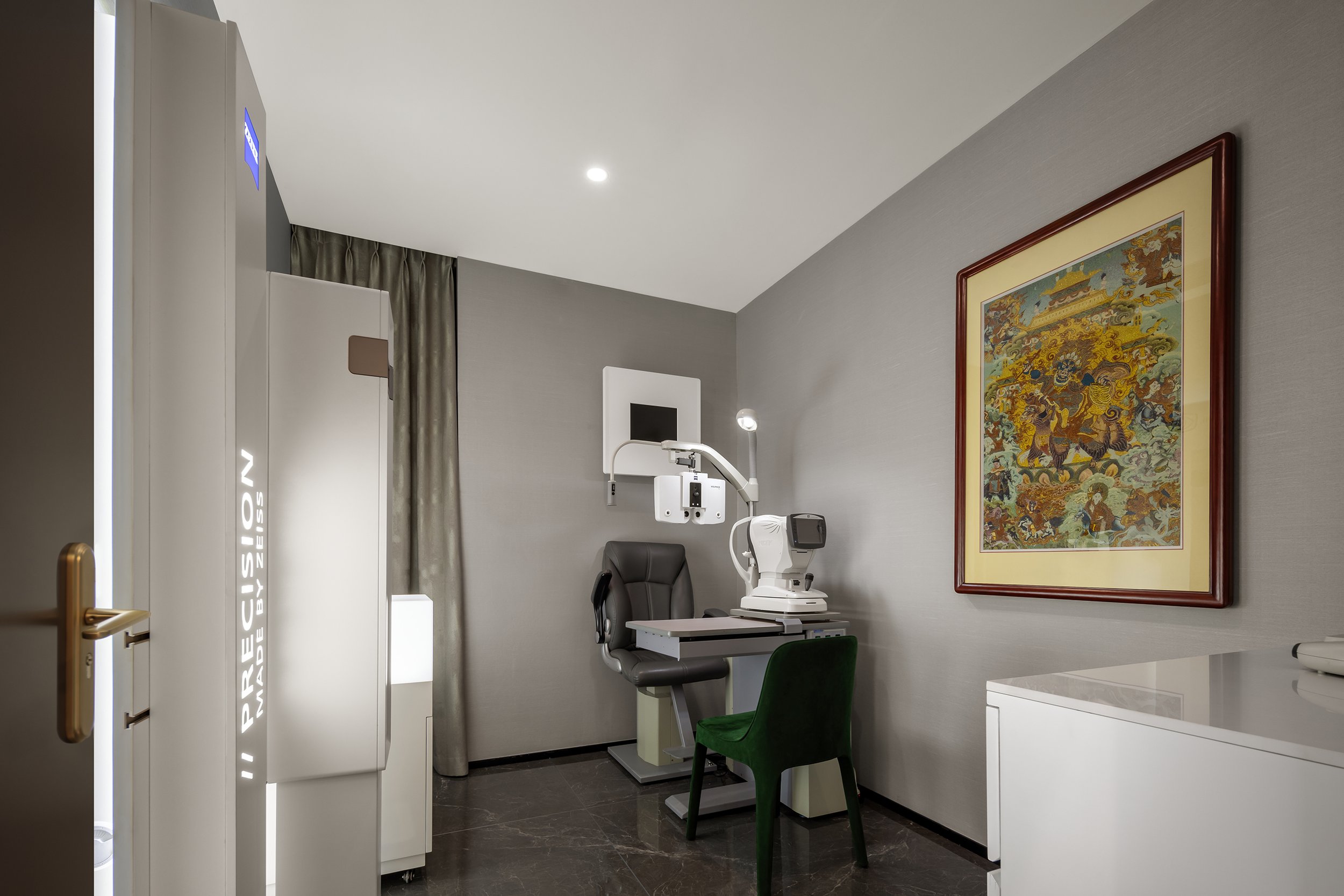
A Curated Selection of World-Class Brands
Shangri-La Eyeglasses is known for its carefully curated selection of the world's most sought-after eyewear brands. The boutique offers an exclusive range of frames from iconic names such as Cartier, Chanel, and Tom Ford, alongside limited-edition collections from avant-garde designers. These cater to the discerning tastes of luxury consumers. Each brand has been carefully chosen for its aesthetic value and craftsmanship, ensuring that every frame embodies the pinnacle of design and functionality.
The boutique offers a variety of custom eyewear options, allowing customers to personalize their frames to match their unique style. This level of customization adds an extra layer of exclusivity, as customers can own a piece that is uniquely theirs, reflecting their personal identity and taste.
The combination of exceptional architecture, thoughtful interior design, and unparalleled service distinguishes Shangri-La Eyeglasses as a leader in Asia's high-end eyewear market. Like Hilton's 'Lost Horizon 'Lost, which mesmerized readers with its portrayal of an earthly paradise, this boutique captivates visitors through its seamless integration of beauty, luxury, and experience—truly encapsulating the essence of Shangri-La.
*This project is one of the shortlisted project in the Sky Design Awards 2024 - Interior Design: Retail Design Division
manu coffee Reimagined: A 20-Year Legacy of Culture and Connection
n the lively Haruyoshi district of Fukuoka, manu coffee has been a central part of the area's evolving subculture for the past two decades. This unassuming yet iconic café has been more than just a coffee place; it has served as a gathering spot for young professionals and a hub where Fukuoka's nightlife culture and creative communities come together. Situated at the unique intersection of the city's three central districts—Tenjin, Hakata, and Nakasu—Haruyoshi has developed into a unique enclave where nightlife, dining, and urban subcultures blend seamlessly. Within this dynamic setting, Manu Coffee has thrived for 20 years, creating its own story and building a dedicated following, a testament to our city's unique and vibrant culture.
In the lively Haruyoshi district of Fukuoka, Manu coffee has been a central part of the area's evolving subculture for the past two decades. This unassuming yet iconic café has been more than just a coffee place; it has served as a gathering spot for young professionals and a hub where Fukuoka's nightlife culture and creative communities come together. Situated at the unique intersection of the city's three central districts—Tenjin, Hakata, and Nakasu—Haruyoshi has developed into a unique enclave where nightlife, dining, and urban subcultures blend seamlessly. Within this dynamic setting, Manu Coffee has thrived for 20 years, creating its own story and building a dedicated following, a testament to our city's unique and vibrant culture.
After 20 years, Takasu Gaku Design and Associates have renovated Manu Coffee to honour its history and encourage new interactions. The new design features a sizeable operable steel sash on the shopfront, creating a transparent space that invites people to look inside and blurs the boundary between the street and the interior. This design aims to bring the energy of the street inside while maintaining the café's role as a cultural hub.
The renovation beautifully combines old and new elements. The counters and bench seating were made using traditional plastering techniques, while the floor has been patched with different materials, preserving its history while giving it a fresh look. These layered textures create a warm and authentic atmosphere, making the space feel familiar yet rejuvenated.
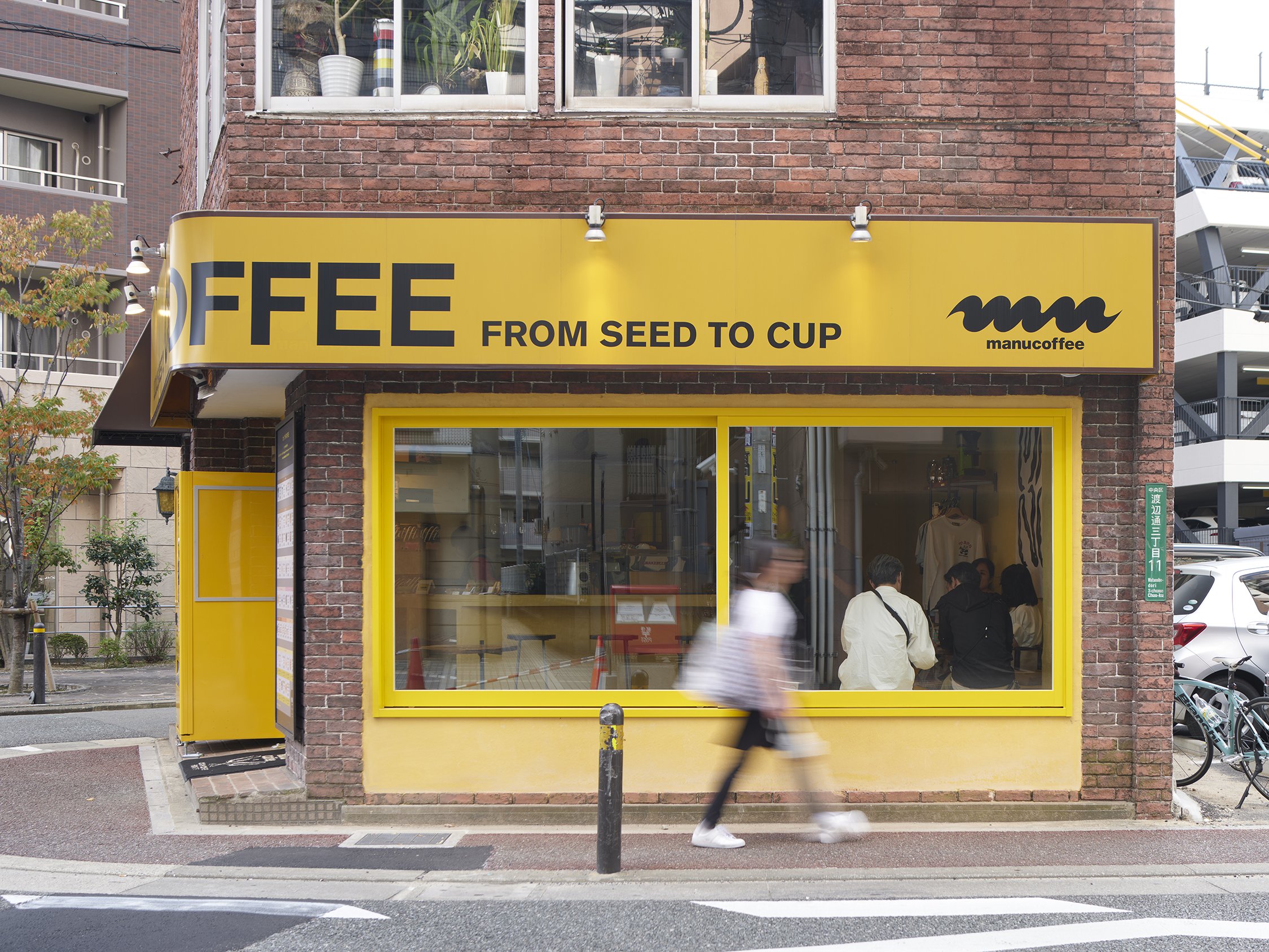




The soft lighting creates a warm and inviting atmosphere, piquing the curiosity of those passing by. The goal is to create a space that feels deeply connected to its surroundings, fostering a sense of continuity, security, and connection between the café's long-standing presence and the ever-evolving city. This renovation is not just about updating a space; it's about strengthening the bond between the café, the street, and the community it serves.
The aim is for this newly designed entrance to serve as both a physical and symbolic gateway, promoting the exchange of ideas and culture, and continuing to shape Haruyoshi's identity. As the café embarks on a new chapter, it will undoubtedly continue its dedicated mission of nurturing Fukuoka's subcultures, serving as a place where the old meets the new, and where the past informs the future, fostering a sense of continuity and anticipation for what's to come.
For more information, please visit: https://gaku-design.com
*This project is one of the shortlisted project in the Sky Design Awards 2024 - Interior Design - Restaurant, Bar & Clubs Division
Designer Profile
Elevating Airport Hospitality: OMO Kansai Airport’s Playful Design Celebrates the Art of Travel
OMO Kansai Airport by Hoshino Resorts, designed by MITSUI Designtec Co., Ltd., offers a unique airport hotel experience. It is the first OMO-branded hotel within an airport, and it involved renovating an existing hotel directly connected to Kansai International Airport, Japan's most significant air gateway to the west. The hotel's location, just steps away from the airport's terminal, ensures a stress-free and convenient stay, providing you with a sense of reassurance and ease. The design combines functionality with a playful urban aesthetic, inviting guests to view their journey as more than just transit but as an integral part of their travel adventure.
OMO Kansai Airport by Hoshino Resorts, designed by MITSUI Designtec Co., Ltd., offers a unique airport hotel experience. It is the first OMO-branded hotel within an airport, and it involved renovating an existing hotel directly connected to Kansai International Airport, Japan's most significant air gateway to the west. The hotel's location, just steps away from the airport's terminal, ensures a stress-free and convenient stay, providing you with a sense of reassurance and ease. The design combines functionality with a playful urban aesthetic, inviting guests to view their journey as more than just transit but as an integral part of their travel adventure.
The hotel's architectural concept is centred around adding "fun" to the guest experience, making it an extension of their journey and a destination. MITSUI Designtec approached the renovation with a focus on balancing practicality and aesthetic innovation. The hotel's design subtly incorporates elements of aviation and the excitement of travel. Notable features include an intricately crafted airplane object as the focal point in the lobby and lighting fixtures that resemble the dynamic form of an airplane turbine. These elements bring a sense of motion and energy to the space, capturing the spirit of flight. They are not just decorative but are intended to immerse guests in the travel experience, visually connecting them to the airport environment while maintaining an elegant, contemporary interior.
The hotel's design takes into account the needs of modern travellers. The spacious, streamlined interiors offer a peaceful retreat from the bustling airport atmosphere, ensuring that you can relax and recharge during your stay. The intentionally neutral colour palette, complemented by warm accents and natural materials, creates a welcoming and functional environment. This calm yet engaging atmosphere provides guests with a space to relax, whether they are staying for a brief stopover or a more extended layover, despite the transient nature of airports.
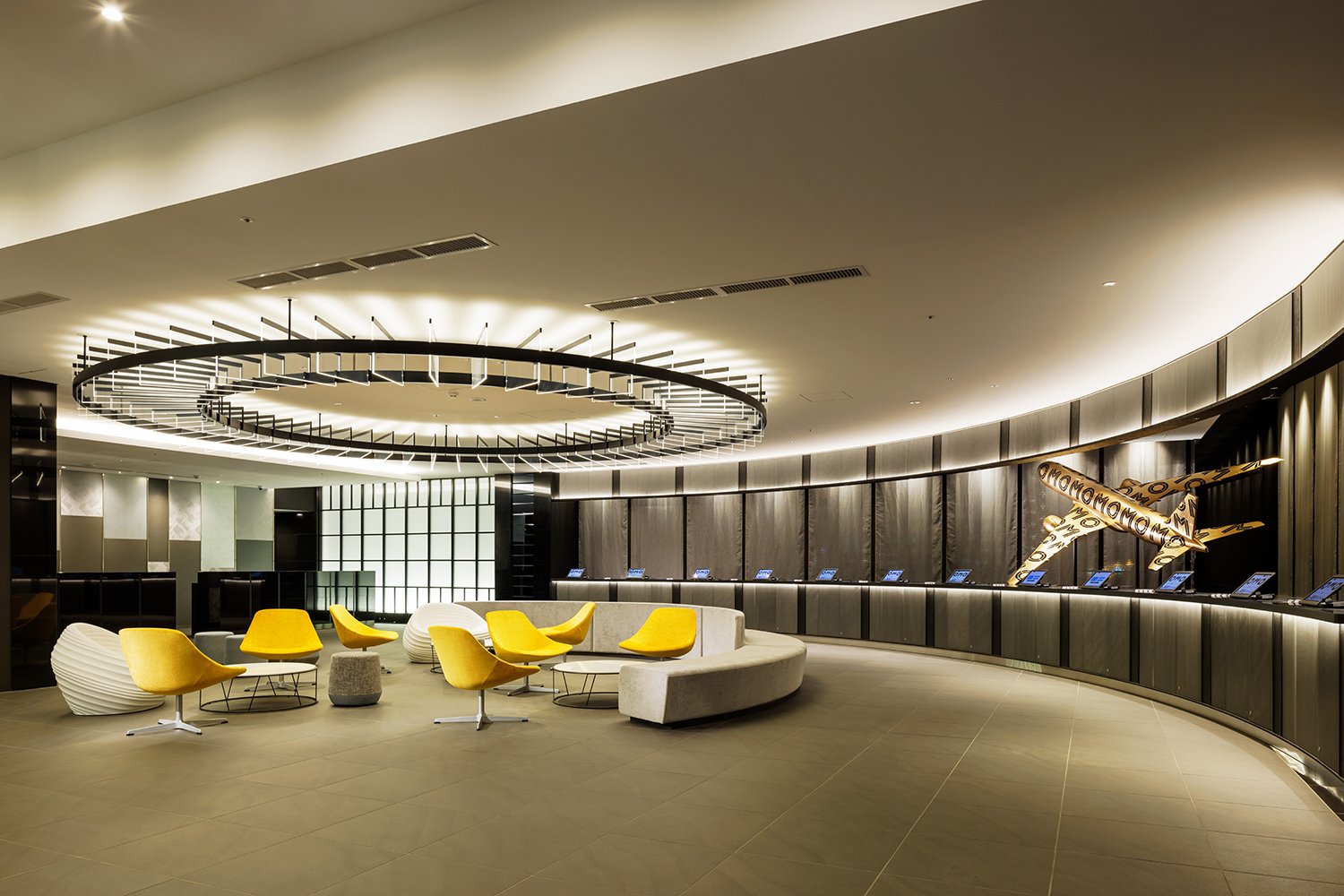
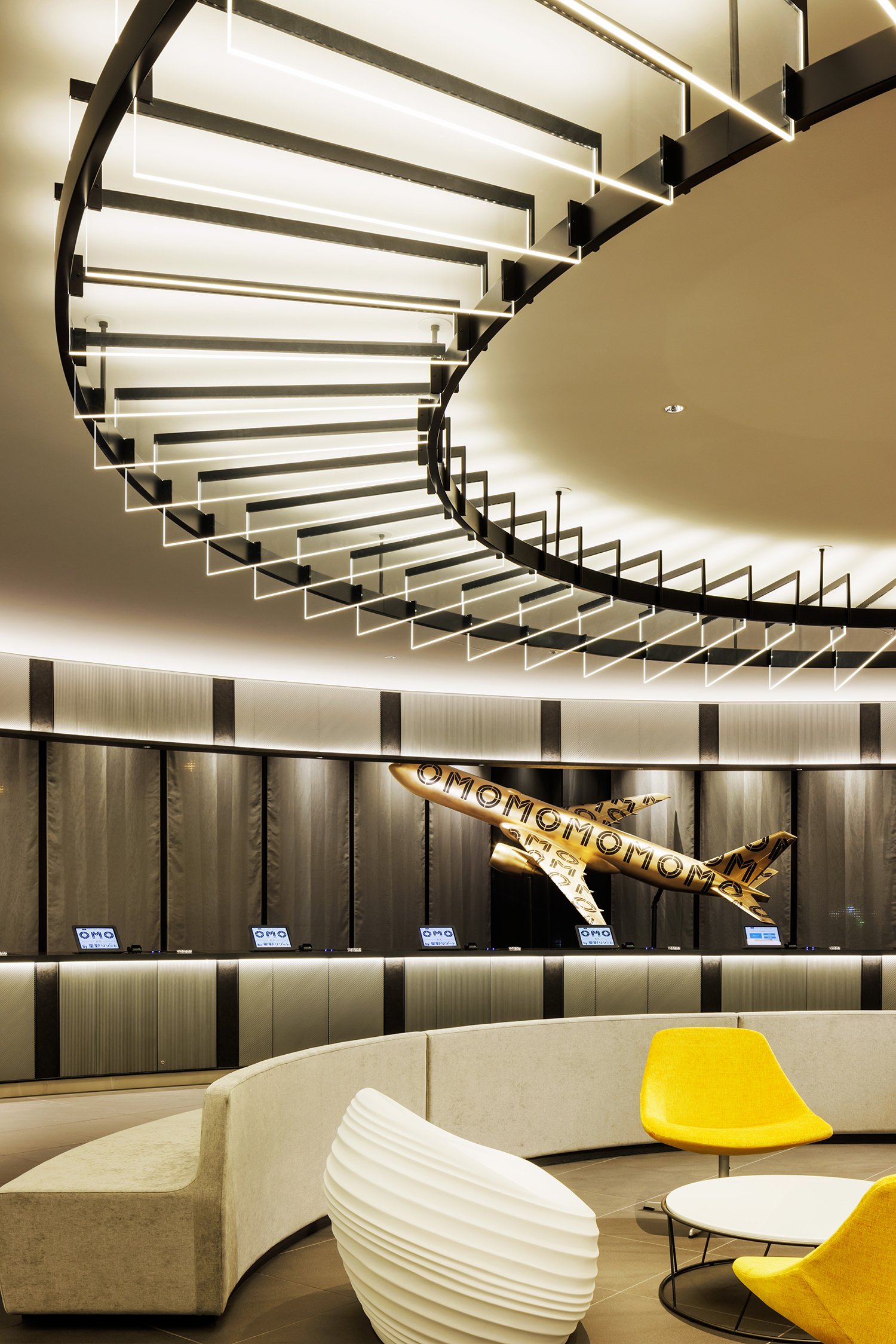
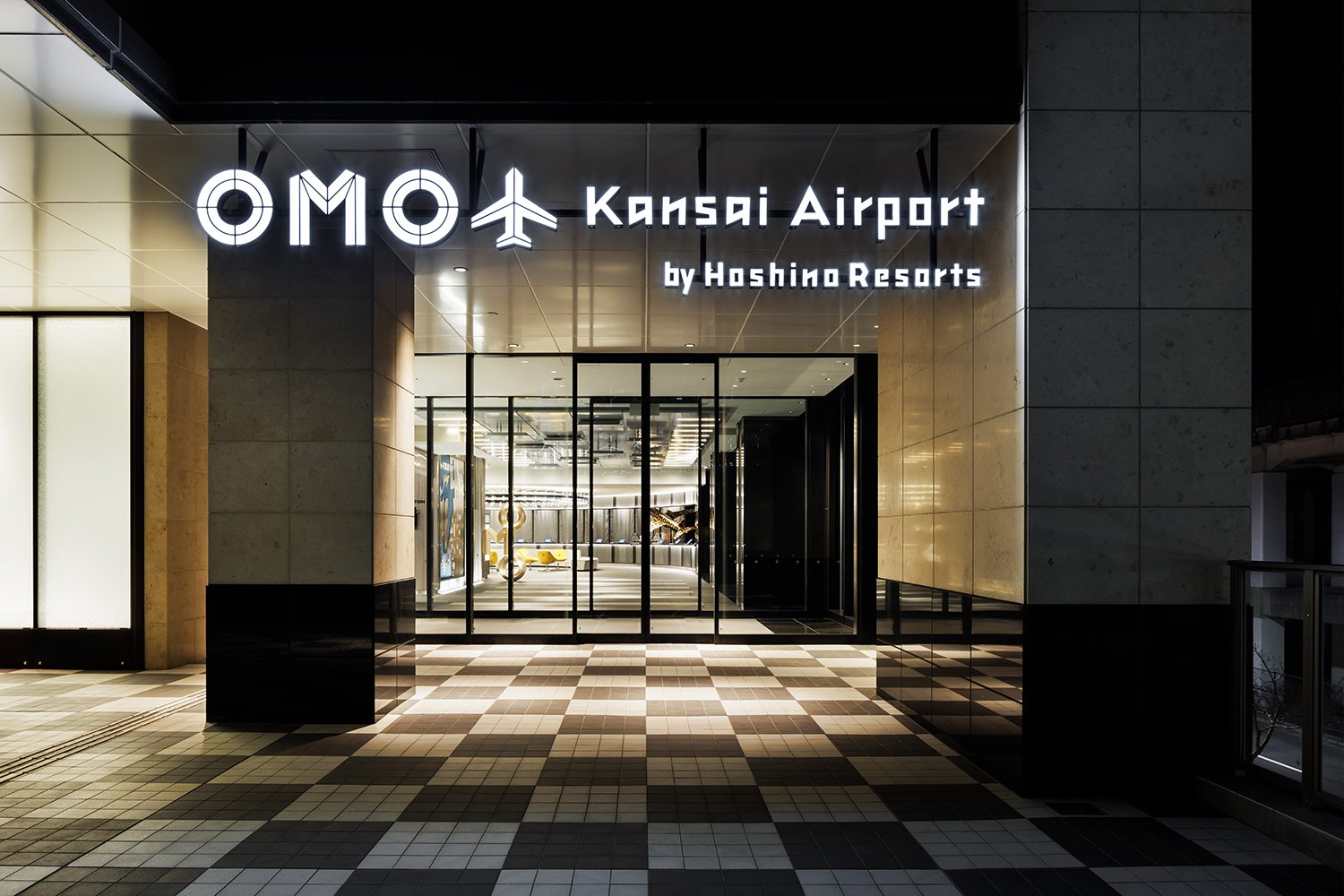


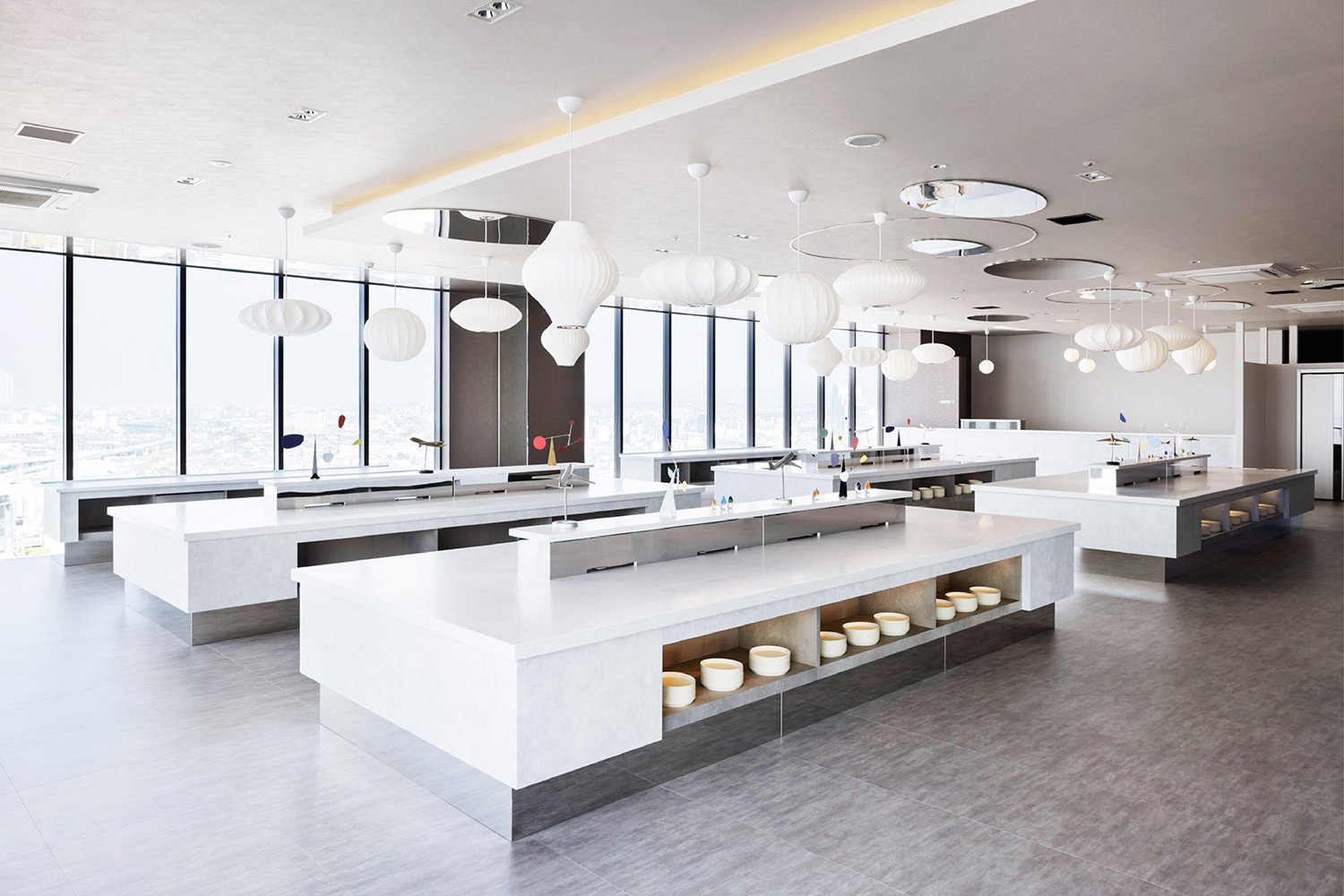
The OMO Kansai Airport emphasizes convenience and ease of movement. The hotel is located just steps away from the airport's terminal and offers unique services such as the 'Airporter' luggage delivery, which allows guests to streamline their travel experience from check-in to check-out. This service is a testament to our commitment to making your stay as stress-free as possible. The overall design facilitates a smooth and efficient stay, with a playful edge that reflects OMO's exciting mission to turn ordinary city experiences into memorable adventures. This promise of adventure is sure to pique the interest of any traveller.
At OMO Kansai Airport, modern travel seamlessly combines functional and whimsical design. MITSUI Designtec's approach creates a space where guests can transition between worlds - whether it's between different time zones, flights, or destinations - while enjoying carefully curated design that enhances the joy of movement, travel, and discovery. This is not just a hotel; it's the perfect bridge between the excitement of journeying and the comfort of arriving.
For more information, please visit: https://www.mitsui-designtec.co.jp/
*This project is one of the shortlisted project in the Sky Design Awards 2024 - Interior Design - Hotel & Resorts Division
Tang Talk: A Fusion of Art and Functionality designed by Jingle Design
In the heart of Taiyuan, Shanxi, a groundbreaking project has come to life, redefining the relationship between space and human experience. Tang Talk, a stunning 617 square meter space designed by the visionary team at Jingle Design, is not just a physical structure but a living, breathing organism inspired by the intricate mechanisms of biomembrane systems. As one steps into Tang Talk, they find themselves engulfed in a world where the boundaries between art and functionality blur into a harmonious symphony of design. The space, transformed into a site for energy conversion, mirrors the inner workings of a cell factory. Every detail, meticulously crafted and thoughtfully placed, exudes a sense of purpose and vitality.
This project draws inspiration from the functional mechanism of the biomembrane system, using the concepts of "functioning" and "transmission" in the design as a metaphor for the relationship between humans and food. The designer has transformed the entire space into a site for energy conversion, resembling a cell factory. Through complex and meticulous operations, a new force of life is generated, ensuring the highest quality and attention to detail. The design breaks away from the traditional "bottom-up" logic of spatial construction, immersing people in an immersive and entirely new world.
The overall space is divided and enclosed with streamlined boundaries, resembling the internal processes within a cell, where material transport, energy conversion, and information transmission interact with the external environment, leading to continuous proliferation and division. The metal mesh structure on the exterior facade extends from repetitive and evenly spaced points to organic curves, further extending into the interior space. Transparent glass facades and funnel-shaped metal crystalline structures serve as visual focal points. The structure of the metal cell cavity makes those inside feel like explorers in a cell factory, where their senses are continually amplified. The relationship between "light & shadow" and "form" is re-captured and reinterpreted.
In the heart of Taiyuan, Shanxi, a groundbreaking project has come to life, redefining the relationship between space and human experience. Tang Talk, a stunning 617 square meter space designed by the visionary team at Jingle Design, is not just a physical structure but a living, breathing organism inspired by the intricate mechanisms of biomembrane systems. As one steps into Tang Talk, they find themselves engulfed in a world where the boundaries between art and functionality blur into a harmonious symphony of design. The space, transformed into a site for energy conversion, mirrors the inner workings of a cell factory. Every detail, meticulously crafted and thoughtfully placed, exudes a sense of purpose and vitality.
The exterior facade, adorned with a mesmerizing metal mesh structure, seamlessly blended repetitive points with organic curves, drawing me deeper into the immersive experience. Transparent glass facades and intricate metal crystalline structures served as visual focal points, capturing the play of light and shadow in a dance of elegance and mystery. Venturing further into Tang Talk, one encounters the awe-inspiring cell membrane biomimetic art installation—a testament to the design team's boundless creativity. The installation, stretching an impressive 13 meters, weaves a multi-dimensional tapestry of interlaced straight and curved lines, inviting active participation in its narrative.
The interplay of light and shadow beneath the ultra-thin metal mesh left me transfixed as if I had stumbled upon a secret world to explore. As I gazed upward, the installation extended above me, beckoning me to embrace the transformative power of design and immerse myself in its captivating allure.Tang Talk is not just a space but a testament to human ingenuity and creativity. It challenges traditional spatial construction, inviting visitors to shed their passive roles and become explorers in a realm where senses are heightened and perceptions are transformed.







In April 2023, Tang Talk will stand as a testament to the collaborative vision of the design team led by Zhou Bo, Cai Yuyang, and Liu Hailong. Their meticulous attention to detail and commitment to pushing the boundaries of design have created a space that transcends the ordinary, leaving an indelible mark on all who enter its hallowed halls.
Tang Talk is more than a design; it is an invitation to embark on a journey of discovery, where art and functionality converge to ignite the imagination and inspire the soul. The cell membrane biomimetic art installation represents a crucial breakthrough and challenge. Lines on the curved surface of the installation appear as if the artist is simulating intricate cutting experiments. After communication and coordination with the professional team, the installation was segmented and assembled within the site, achieving a maximum length of 13 meters. It creates a multi-dimensional effect with interlaced straight and curved lines. The installation extends above the space, transforming the experience for people from passive observation to active engagement, making them feel like they are part of the project. The ultra-thin metal mesh imparts a sense of lightness to the installation. Beneath it, the play of light and shadow appears mysterious and flickering.
Project Information
Project Name | Tang talk
Project Address | Taiyuan, Shanxi
Project Area | 617 sq. m
Completion Date | April 2023
Design Firm | Jingle Design
Design Director | Zhou Bo, Cai Yuyang
Lead Designer | Liu Hailong
Design Team | Zhang Junzi, Cui Qiwei, Kong Xiangyu, Du Qiurong, Chang Huan, Zhou Guicong, Wu Tong
Photography | TOPIA Vision
Main Materials | Metal pipes, Metal mesh, Texture paint, Stone, Mirror finish stainless steel
*This project is one of the shortlisted project in the Sky Design Awards 2024 - Interior Design: Restaurant & Club Division
Bird Water Tower: FLIP Studio's Bold Revival of Industrial Heritage and Art at Shanghai's M50 Creative Park
Located in the northwest corner of Shanghai's M50 Creative Park, a hub for contemporary art and design, the Bird Water Tower is a captivating blend of the old and the new. Standing next to Heatherwick Studio's famous 1000 Trees, this historic water tower has existed for over fifty years. Previously owned by the well-known artist and curator Bing Su, the tower was unused for many years until FLIP Studio converted it into a vibrant venue for modern art and social gatherings.
Located in the northwest corner of Shanghai's M50 Creative Park, a hub for contemporary art and design, the Bird Water Tower is a captivating blend of the old and the new. Standing next to Heatherwick Studio's famous 1000 Trees, this historic water tower has existed for over fifty years. Previously owned by the well-known artist and curator Bing Su, the tower was unused for many years until FLIP Studio converted it into a vibrant venue for modern art and social gatherings.
"The renovation of the Bird Water Tower offers an exploration of temporal layers. Visitors can physically and metaphorically navigate through Shanghai's industrial past while being immersed in modern artistic expression. FLIP Studio's design approach embraces the structure's worn and weathered character while introducing a new architectural language that engages with the old."
Outdoor Experience: A Gateway Between Eras
The journey starts in the outdoor area, where FLIP Studio has skillfully incorporated a network of platforms, bridges, and stairways to create an architectural promenade leading to the tower. These new pathways are marked by black-rusted steel handrails and balustrades, clearly distinguishing between old and new while maintaining a respectful enclosure. These changes serve as connectors and indicate the visitor's transition into a redefined space where history meets innovation.
Dual Interiors: Raw Elegance Meets Refined Modernity
The interior of the Bird Water Tower has been divided into two distinct spaces: one square and the other rectangular, each offering a unique spatial experience. A narrow outdoor terrace acts as a slender seam, joining the two spaces while providing a brief breath of fresh air between the roughness of the past and the precision of contemporary design.
FLIP Studio chose to reveal the structure's raw, industrial character in the square hall. Exposed dark gray cement walls bear the scars of time, with traces of demolished interior partitions intentionally left visible. A boldly inserted black-painted OSB coffee bar creates a monolithic "black box" that contrasts sharply with the gritty backdrop. The pink neon lighting adds a surreal, almost cinematic atmosphere, blurring the lines between the industrial heritage and the contemporary art world.
The rectangular hall contrasts with subtler gestures. A white box has been carefully placed in this space, covering two-thirds of the height and leaving the original ceiling exposed. The contrast between new and old is more noticeable in this room, especially where the white box meets the existing brick walls, terrazzo cladding, and exposed structural elements. These layers are revealed like an "architectural anatomy," a concept that aims to showcase the building's structural elements and materials, reminiscent of Gordon Matta-Clark's work, where cut walls and raw materials evoke a dialogue between past and present.
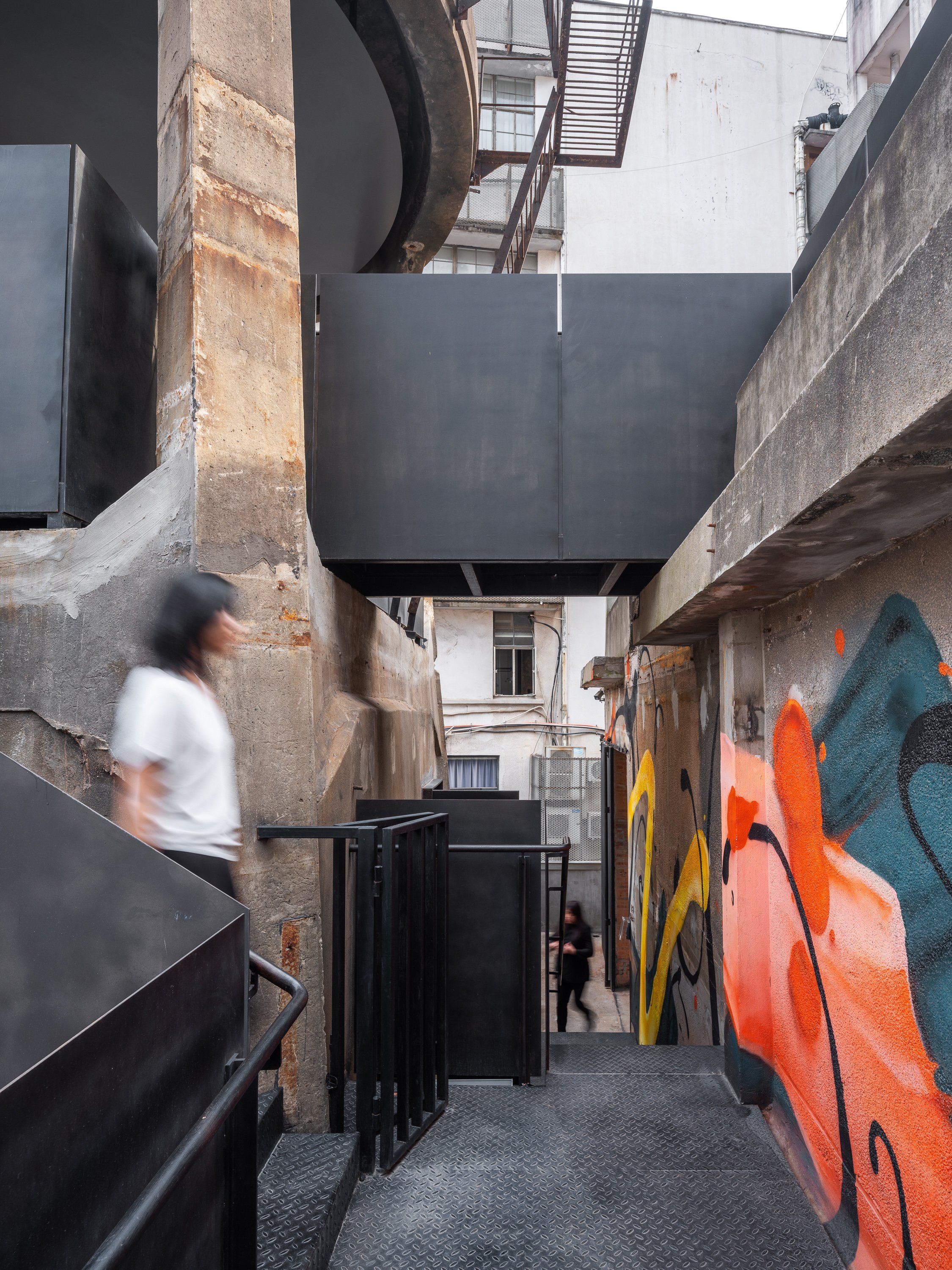
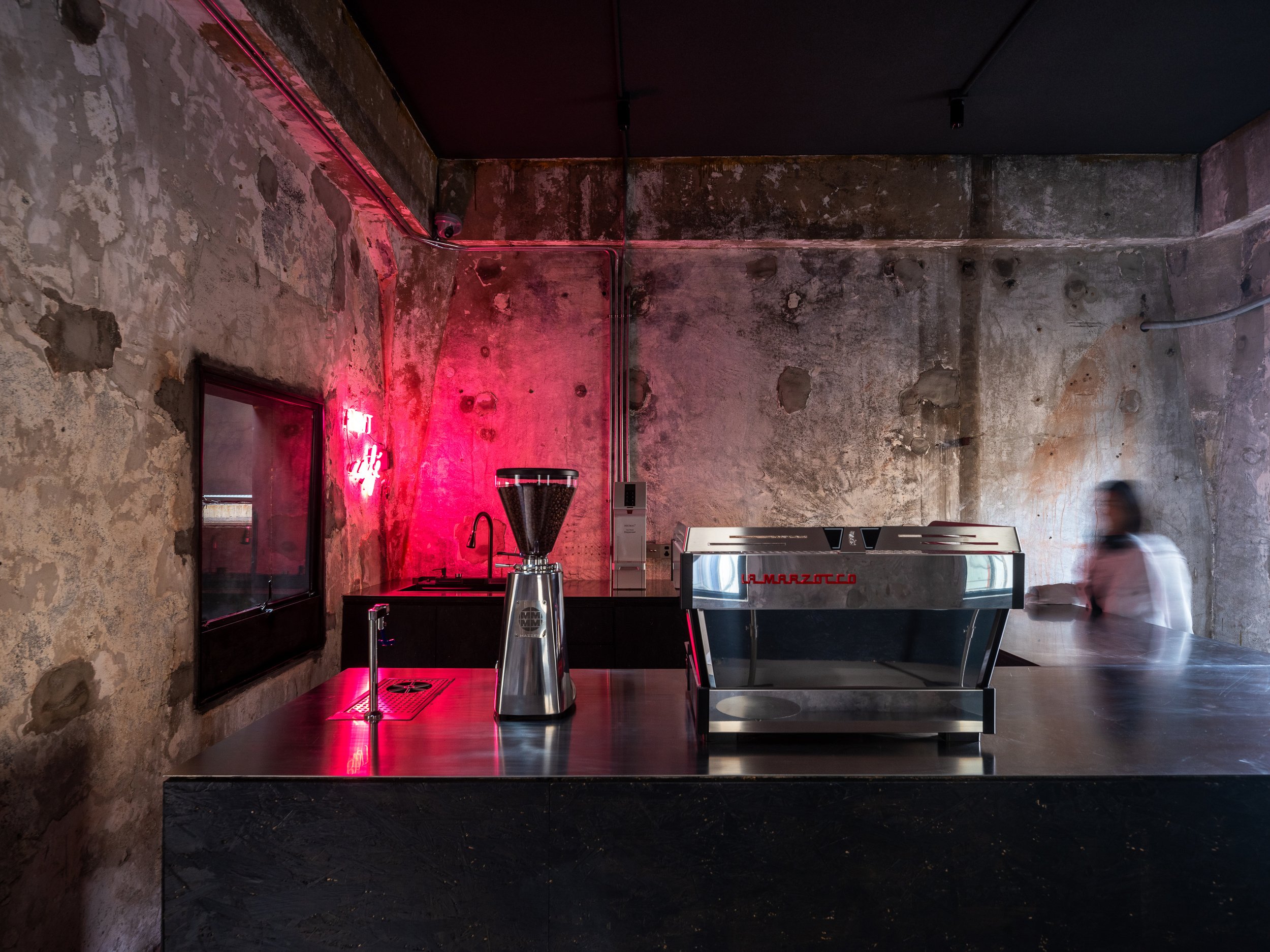
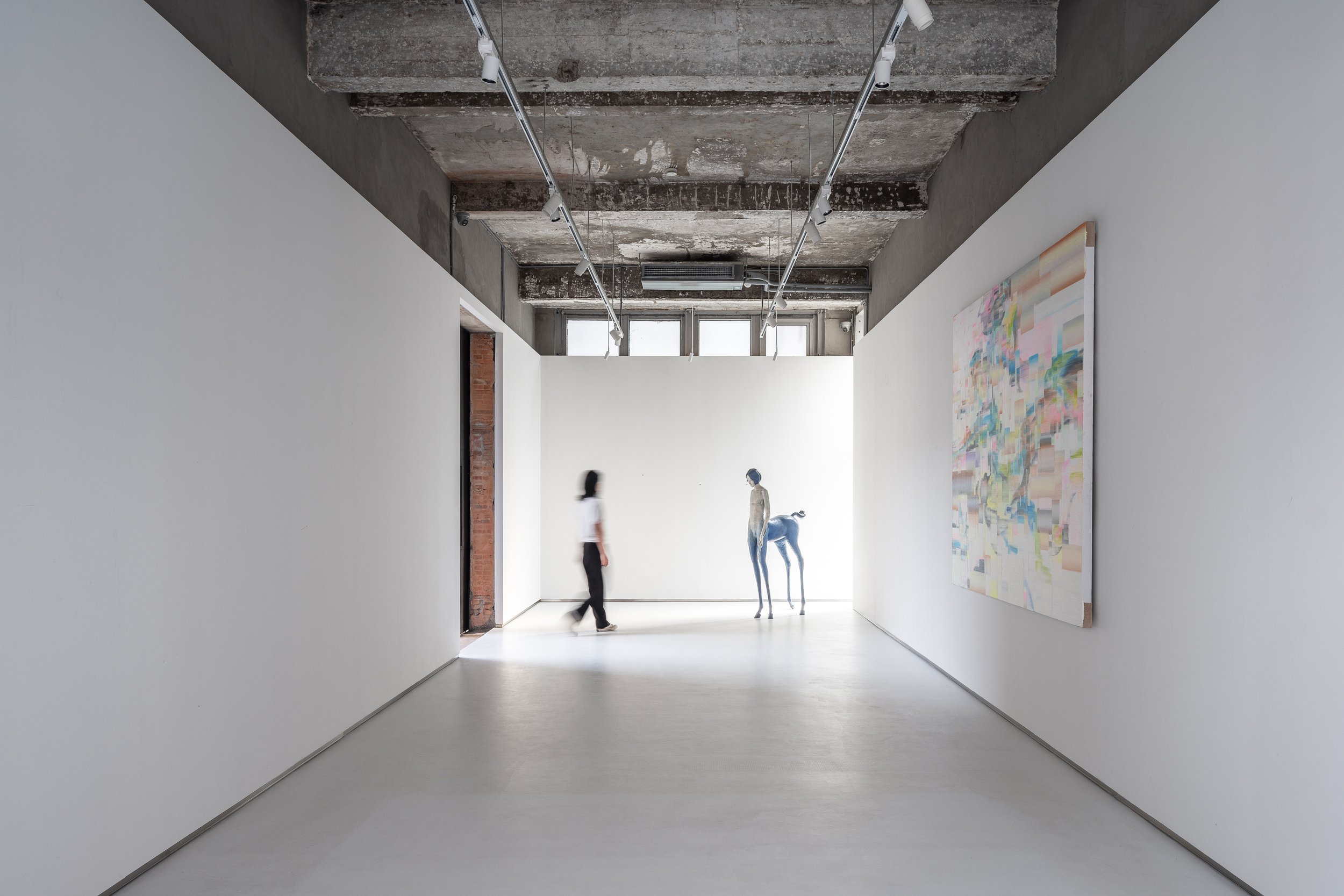
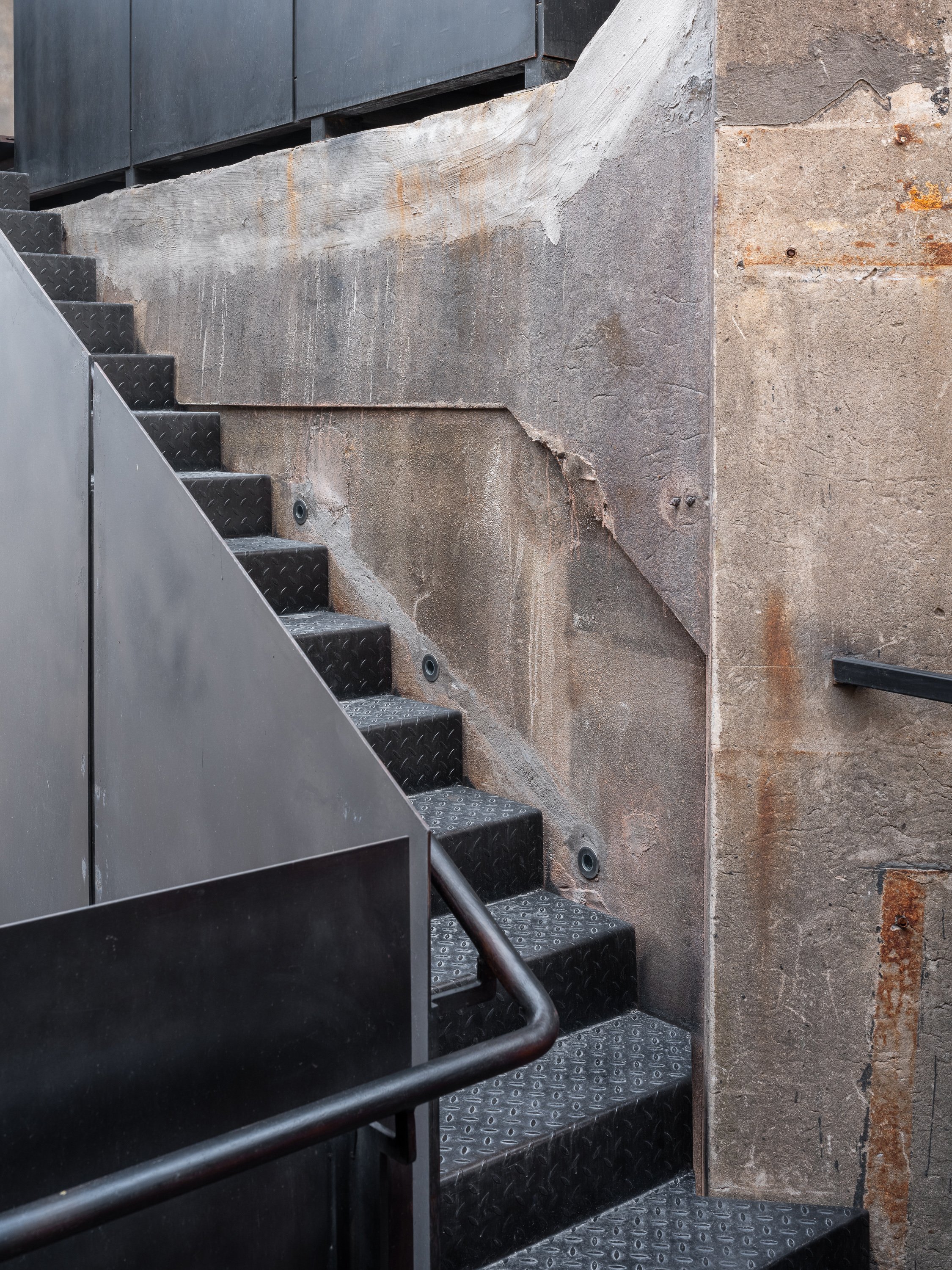
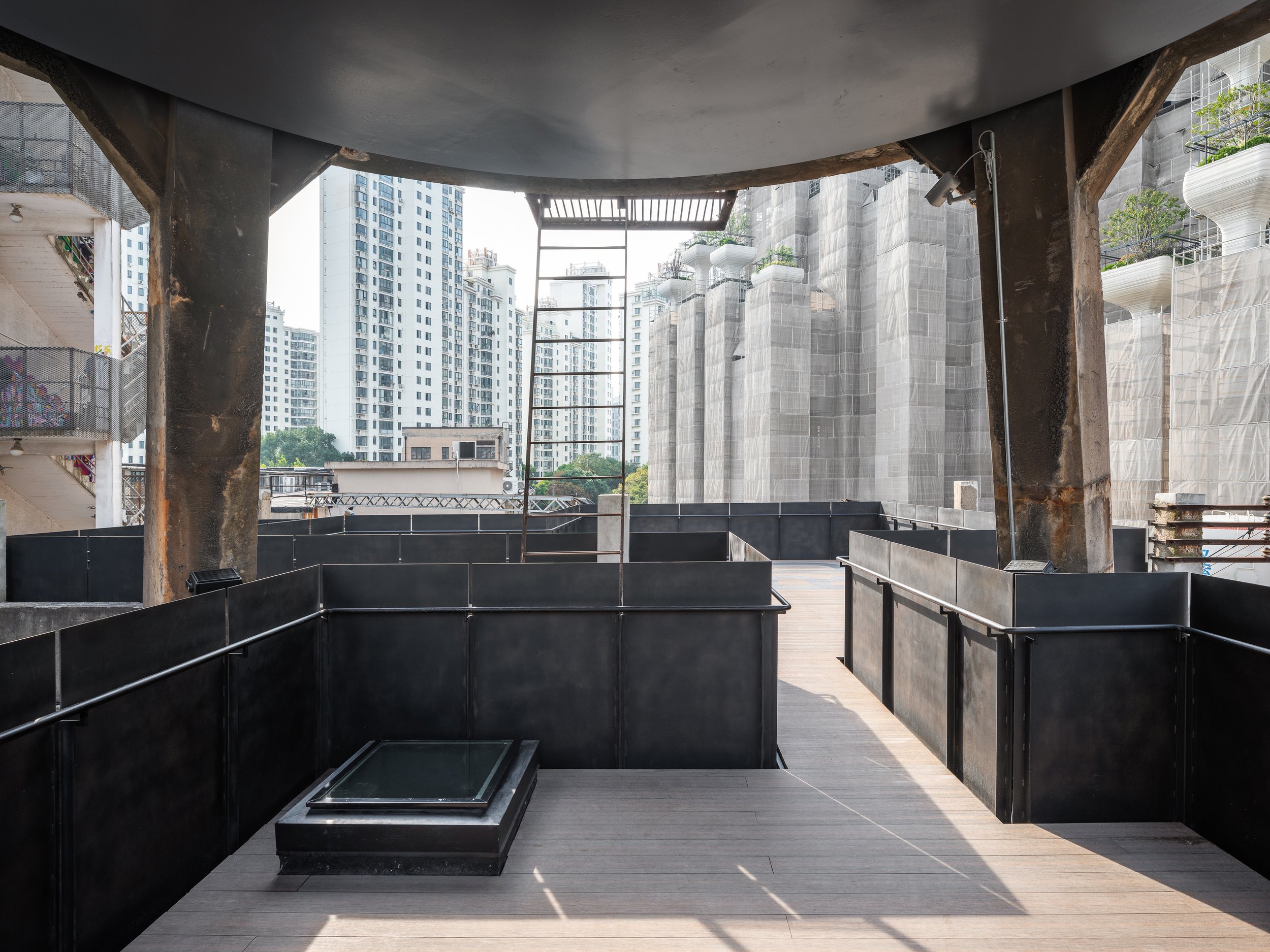
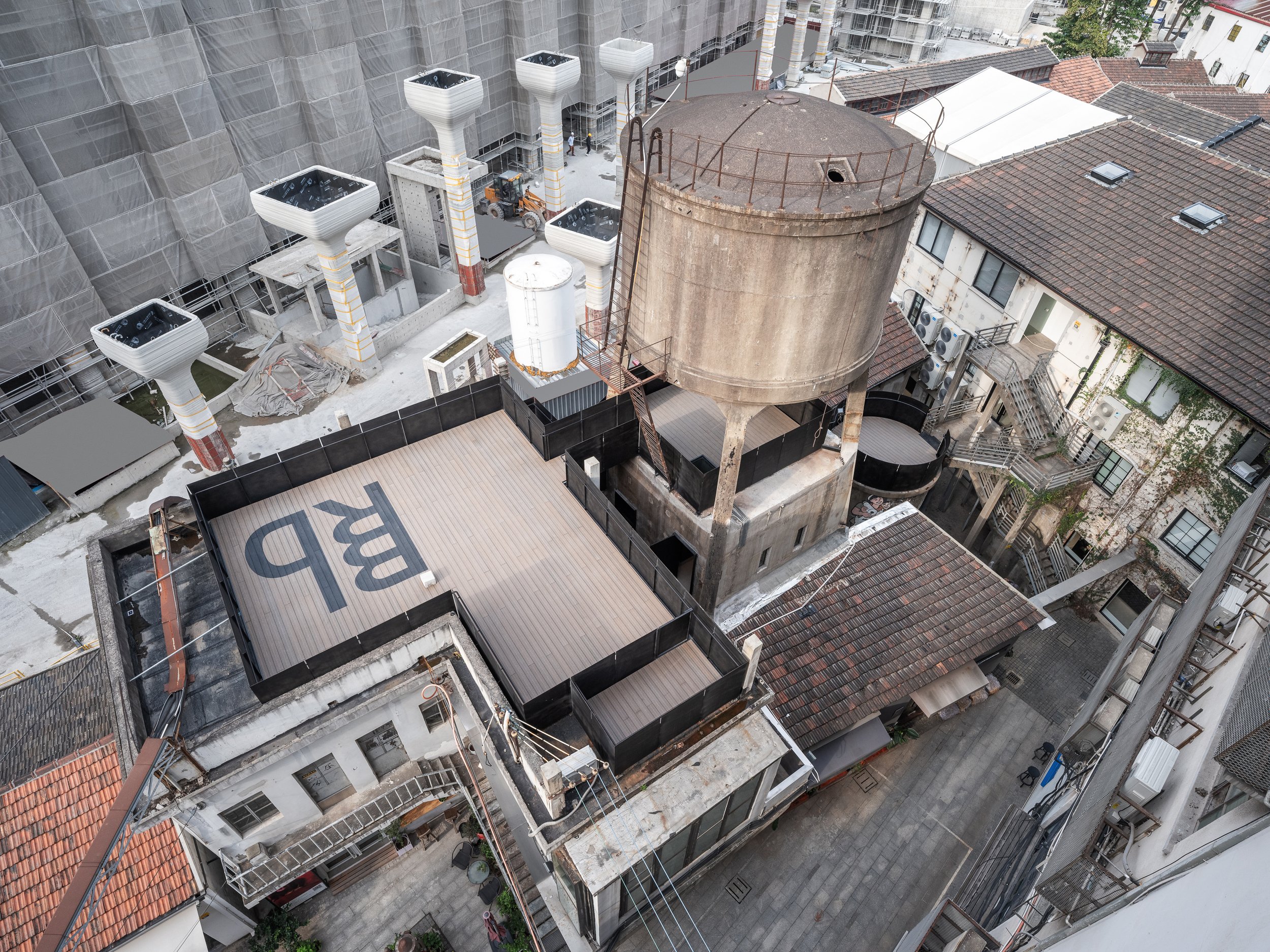
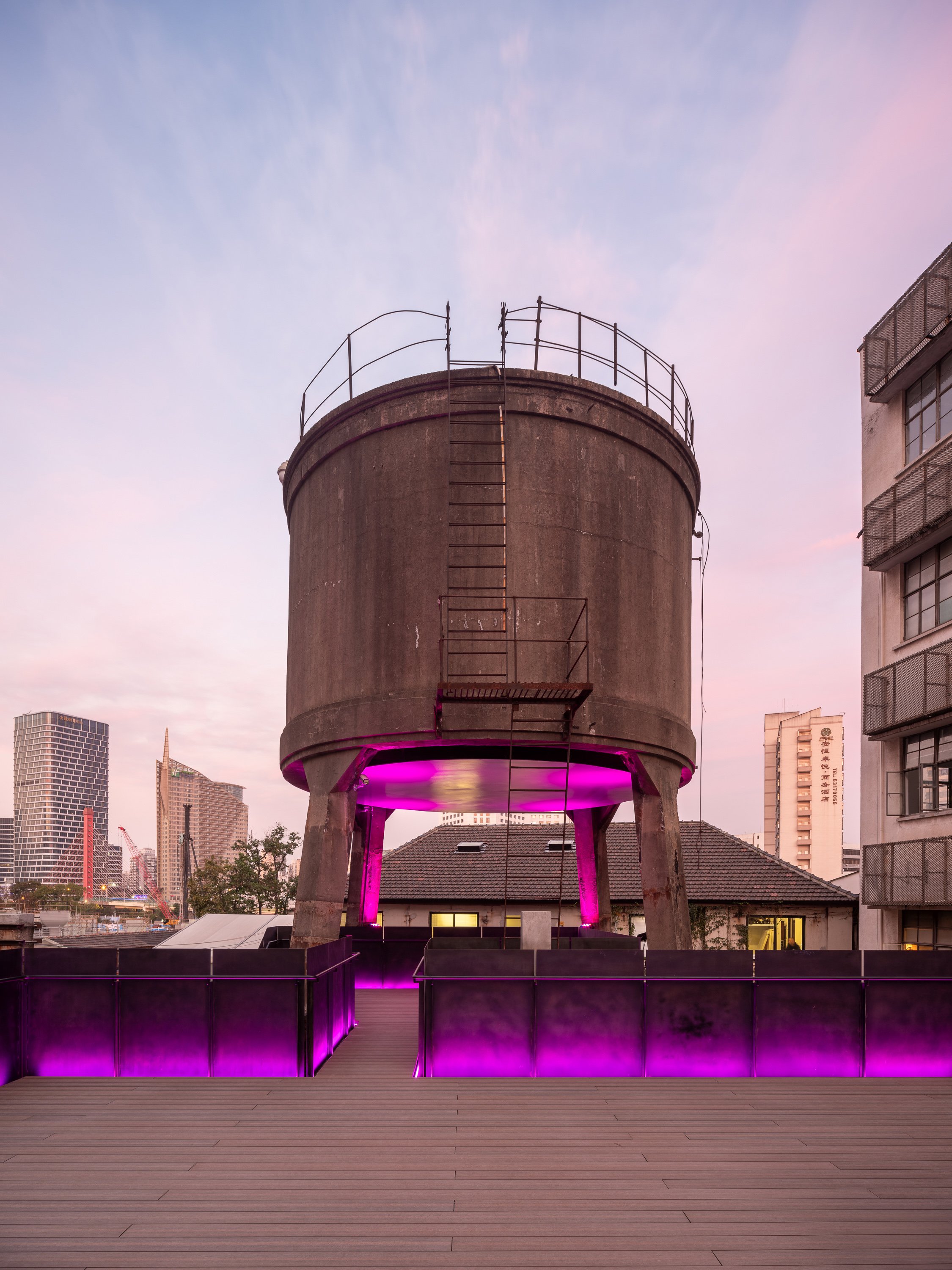
Art and Space: A Curatorial Journey
Art plays a crucial role in guiding visitors through the tower. Strategic placement of installations, graffiti, paintings, and video art punctuate the spatial experience. Key pieces act as navigational markers along the circulation path. An example of this is the untouched wall along the newly inserted staircase, where a live graffiti performance brought the raw energy of street art into the space during the pre-opening phase.
A polished metal plate suspended at the tower's base adds another dimension to the curation. This surface is a canvas for projected digital art, creating a fluid, ever-changing dialogue between physical architecture and ephemeral media.
A Beacon of Light and Art
The Bird Water Tower becomes a glowing beacon in the quiet M50 Creative Park at night. It is adorned with vibrant neon lights and dynamic projections, making it a lighthouse from another dimension. The interplay of light, shadow, and art creates an inviting space where time feels suspended, and the boundaries between past and future dissolve.
The revival of the Bird Water Tower is a testament to Shanghai's industrial heritage and an experiment in the intersection of architecture, art, and urban regeneration. FLIP Studio's sensitive yet inventive intervention has transformed this once-abandoned space into a landmark of creative expression that encourages exploration, contemplation, and conversation.
Project Name:M50 Bird Water Tower
Project Location:Shanghai, China
Lead Designer: Kailun Sun
Area:230㎡
Design Team:Zixuan Chen
Photo:Fangfang Tian
Completion:2023.08
For more information, please visit: www.flip-studio.com
*This project is one of the shortlisted project in the Sky Design Awards 2024 - Architecture Division







